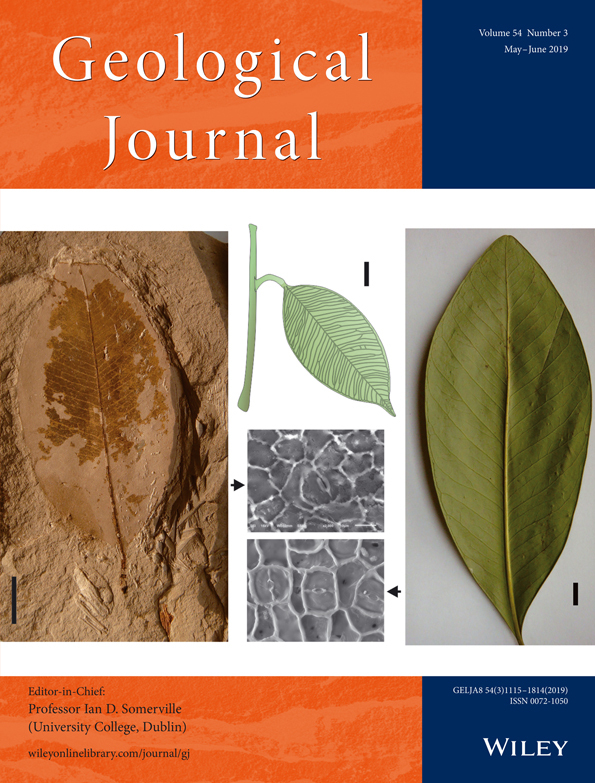Geochronology, petrogenesis, and tectonic implications of the Early Permian volcanic rocks in the northern margin of the North China Craton
Abstract
We present new zircon U–Pb ages, geochemical data on the Late Palaeozoic volcanic rocks of the Suji and Dahongshan formations, which are exposed in the Plate Marginal Orogenic Belt along the northern margin of the North China Craton. Our aim is to constrain the petrogenesis, tectonic setting of volcanic rocks, and to address the late stage tectonic evolution of the Paleo-Asian Ocean. Lithologically, the Suji and Dahongshan formations present the main rock association with basaltic andesite, andesite, dacite, rhyolite, and tuff. New zircon U–Pb dating results suggest that the volcanic rocks formed during 280–261 Ma and 277–267 Ma, respectively. Geochemically, these volcanic rocks belong to the low-K tholeiitic to high-K calc-alkaline series and are characterized by highly enriched light rare earth elements, K, Rb, Ba; depleted Nb, Ta, Ti; and highly negative Eu anomalies, very similar to that of the continental arc magmatism. These data, together with geological field investigations, suggest that the Early Permian volcanic rocks from Suji and Dahongshan formations were related to southward flat subduction of the Paleo-Asian Ocean beneath the northern margin of the North China Craton. Therefore, these volcanic rocks were interpreted as Andean-style continental margin arc magmatism. This also indicates that the final collision between the North China Craton and the Siberian Craton did not occur until the Early Permian.
1 INTRODUCTION
The Paleo-Asian Ocean (PAO) separating the Siberian Craton (SC) in the north and the North China and Tarim cratons in the south was developed in the result of the breakup of the Rodinia supercontinent since the Neoproterozoic and its consumption and closure in Late Palaeozoic or Early Mesozoic period eventually led to the formation of the Central Asian Orogenic Belt (CAOB), which is a giant phanerozoic accretionary orogeny on Earth (e.g., Badarch, Gunningham, & Windley, 2002; Charvet, Shu, & Laurent-Charvet, 2007; Chen, Jahn, Simon, & Xu, 2000; Chen, Jahn, & Tian, 2009; Dobretsov, 2003; Jahn, Griffin, & Windley, 2000; Jahn, Litvinovsky, Zanvilevich, & Reichow, 2009; Jahn, Windley, Natal'in, & Dobretsov, 2004; Jahn, Wu, & Chen, 2000a, 2000b; Jahn, Wu, & Chen, 2001; Jian et al., 2008; Jian et al., 2012; Jian, Liu, & Kröner, 2010; Kröner et al., 2007; Li et al., 2012; Li et al., 2016; Li et al., 2017; Li, Santosh, & Jahn, 2012; Liu, Liu, & Zhou, 2014; Sengör, Natal'in, & Burtman, 1993; Wang et al., 2009; Wang et al., 2017; Wilhem, Windley, & Stampfli, 2012; Windley, Alexeiev, Xiao, Kroner, & Badarch, 2007; Wu et al., 2011; Wu et al., 2017; Wu, Jiang, Liu, & Liu, 2014; Wu, Jiang, Liu, Zhang, & Zhou, 2015; Xiao et al., 2004; Xiao et al., 2009; Xiao, Windley, Hao, & Zhai, 2003; Xu et al., 2014; Figure 1). The terminal evolution of the PAO in Inner Mongolia is recorded by the major regional lineament: the Solonker Suture Zone (SSZ; Windley et al., 2007; Wu, Zhao, Sun, Wilde, & Yang, 2007; Xiao et al., 2003; Xiao et al., 2009; Xiao et al., 2017; Xiao, Sun, & Santosh, 2015). Understanding the late-stage evolution of the PAO has two fundamental implications: (a) Its evolution history provides an observational basis for quantifying the late-stage tectonic model of the PAO (Jian et al., 2008; Jian et al., 2010; Xiao et al., 2003, 2009; Zhang et al., 2014); (b) its tectonic model provides a key constraint on the evolution history on the CAOB (Jian et al., 2008; Jian et al., 2010; Xiao et al., 2003, 2009; Zhang, Zhao, Ye, Liu, & Hu, 2014). Despite this importance, no consensus has been reached on the late-stage evolution process of the PAO.
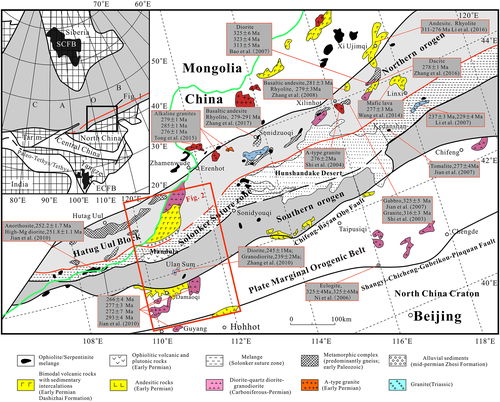
There is still much controversy concerning the timing and location of the closure of the PAO. Some researchers proposed that the Hegenshan-Heihe Suture in Inner Mongolia represents the final closure of the PAO, and it's formed during the Late Devonian–Early Carboniferous (Guo, 1991; Kravchinsky, Cogne, Harbert, & Kuzmin, 2002; Mueller et al., 1991; Tang, 1990; Zorin, 1999). The other researchers favoured that the Solonker-Xra Moron Suture marks the final closure of the PAO, and it formed during the Late Permian–Early Triassic (e.g., Jian et al., 2008; Jian et al., 2010; Li et al., 2017; Liu et al., 2016; Shen, Zhang, Shang, & Li, 2006; Wang et al., 2017; Wang, Liu, et al., 2017; Xiao et al., 2003, 2009). Song et al. (2015) proposed that two cycles/epochs of oceans (the Old/Young PAO) could exist in the south-eastern CAOB according to formation ages of ophiolites and the nearly concurrent magmatic activity. Moreover, the late-stage tectonic model of the PAO in this region remains controversial, with two major schools of thought, that is, single-sided subduction (Jian et al., 2008; Jian et al., 2010) and double-sided subduction (Xiao et al., 2003, 2009; Zhang, Gao, et al., 2014).
The Plate Marginal Orogenic Belt formed along the northern margin of the North China Craton (NCC) in the end of the Early Permian to Middle Triassic (Li et al., 2017), and it is a key area for analysing the late-stage tectonic evolution of the PAO. There are two belts of Early Permian volcanic rock formed along the southern-northern margin of the Plate Marginal Orogenic Belt (Li et al., 2017; Zhang, Zhao, Liu, & Zhao, 2016; Figure 1). In this paper, our new geochronological and geochemical data of the Early Permian volcanic rocks collected from the southern-northern margin of the Plate Marginal Orogenic Belt are used to discuss the sources and petrogenesis of these volcanic rocks. In additional, integration of the previous geochronological and geochemical data are used to provide an updated view of the late-stage tectonic evolution of the PAO, which also provide important insights into an understanding of formation and evolution of the CAOB.
2 GEOLOGICAL BACKGROUND
The study region can be divided into four domains from north to south (Figure 1): Northern orogen, SSZ, Southern orogen, and Plate Marginal Orogenic Belt (Jian et al., 2008; Jian et al., 2010; Li et al., 2017; Xiao et al., 2003, 2009; Xu et al., 2014; Xu, Charvet, Chen, Zhao, & Shi, 2013).
The Northern orogen is connected west to the Hutag Uul Block in Mongolia (Badarch et al., 2002), which includes three main tectonic units from south to north (Jian et al., 2008): Xilinhot metamorphic complex, Erdaojing subduction–accretion complex, and Baolidao Arc. The Xilinhot metamorphic complex (Shi et al., 2003; Tang, 1990) consists of schist, paragneiss, orthogneiss, amphibolite, and ultramafic rocks with an orthogneiss (U–Pb 437 ± 3 Ma; Figure 1). The Erdaojing subduction–accretion complex consists of chert, limestone, dolomite, sandstone, dunite, harzburgite, lherzolite, low-Ti tholeiitic basalt, and rare gabbro and blueschist (Ar–Ar 383 ± 13 Ma; Xu, Charvet, & Zhang, 2001; Zhang & Wu, 1999). The Baolidao Arc is composed of variably deformed diorite, quartz diorite, tonalite, and granodiorite, which intruded the Erdaojing complex and was intruded by the Early Mesozoic granites (Jian et al., 2008; Jian et al., 2010). Diorite has an emplacement U–Pb age of 490 ± 8 Ma (Chen et al., 2000). The Late Devonian conglomerate unconformably overlies the Early- to Mid-Palaeozoic units (Xu & Chen, 1997). The Late Palaeozoic magmatisms are widely exposed across the Northern orogen, including the Carboniferous calc-alkaline plutons (approximately 328–308 Ma) (Bao et al., 2007; Jian et al., 2007; Shi et al., 2003), Late Carboniferous–Early Permian (approximately 311–276 Ma) bimodal volcanic rocks (Zhang, 2008; Li et al., 2016; Zhang et al., 2017), and undeformed A-type granites (276 ± 2 Ma; Shi et al., 2004).
The SSZ tectonically separating Southern orogen and Northern orogen (Figure 1; Jian et al., 2008, Jian et al., 2010) was the final suture zone of the CAOB (Xiao et al., 2003). This suture zone is recorded by the remnants of arcs, ophiolites, and melanges (Zhang et al., 2017). However, there are still some researchers who argued that the Ligurian-type ophiolite characteristics of this zone indicate an extensional tectonic setting (Song et al., 2015; Xu et al., 2014).
The Southern orogen comprises the Ondor-Sum subduction–accretion complex and the Bainaimiao Arc (Figure 1; Jian et al., 2008, Jian et al., 2010). The Ondor-Sum subduction–accretion complex is an Early- to Mid-Palaeozoic arc-trench complex comprising a subduction–accretion complex with blueschist, an SSZ-type ophiolite (approximately 497–477 Ma; Jian et al., 2008; Song et al., 2015; Wu et al., 2016). The Bainaimiao Arc is an island arc (approximately 488–438 Ma; Tang & Yan, 1993; Jian et al., 2008; Wu et al., 2016). Both of them are unconformably covered by the Palaeozoic strata (Hu, Xu, & Niu, 1990). The Palaeozoic strata are dominated by sedimentary sequences from the Ordovician to the Early Permian (Gu et al., 2012; Liu et al., 2016).
The Plate Marginal Orogenic Belt along the northern margin of the NCC, once also called the Inner Mongolia Palaeo-uplift, is mainly composed of Early Precambrian basement unconformably covered by Mesoproterozoic–Neoproterozoic units and Jurassic–Cretaceous volcanic–sedimentary rocks, which is separated from the Southern orogen to the north by the Chifeng-Bayan Obo Fault and the NCC to the south by the Shangyi-Chicheng-Gubeikou-Pinquan Fault (Figures 1 and 2; Li et al., 2017; Zhang, Zhao, et al., 2014; Zhang, Zhao, & Song, 2007; Zhou, Zhang, Liu, Liu, & Liu, 2009). Along the southern-northern margin of the Plate Marginal Orogenic Belt are respectively two belts of Early Permian volcanic rocks (Jian et al., 2010; Li et al., 2017; Zhang, Zhao, et al., 2016). The Late Palaeozoic to Mesozoic intrusive rocks are widely exposed across the Plate Marginal Orogenic Belt (Li et al., 2017; Wu et al., 2016; Zhang et al., 2007; Zhang et al., 2009; Zhang, Liu, et al., 2016; Zhou et al., 2009).
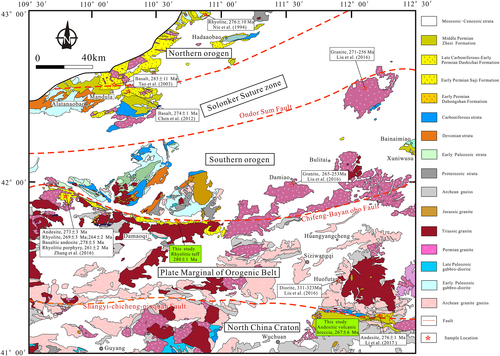
The study area is characterized by widespread Late Palaeozoic volcanic rocks (Figures 1 and 2). Previous studies suggested that these volcanic rocks mainly developed in the Early Permian, with some small amounts formed in the Late Carboniferous (Fu et al., 2016; Li et al., 2014, 2015; Li et al., 2016; Zhang, 2008; Zhang, Zhao, et al., 2016; Zhu, Sun, & Gu, 2001). The Late Carboniferous–Early Permian volcanic rocks are classified by several stratigraphic schemes on the basis of their locations or the researchers (IMBGMR, 1991; Mueller et al., 1991; Shen et al., 2006).
The Early Permian volcanic–sedimentary strata exposed in the northern margin of the Plate Marginal Orogenic Belt are called the Suji Formation (Figures 1 and 2). This Formation is mainly composed of andesite, andesitic volcanic breccia, dacite, rhyolite, rhyolitic porphyry, and tufaceous sandstone (IMIGS, 2003). Zircon U–Pb ages from the Suji Formation volcanic rocks in the Bayan Obo-Damaoqi area suggested that those occurred at 278–261 Ma (Zhang, Liu, et al., 2016). The geochemical data from Suji Formation volcanic rocks in the Bayan Obo-Damaoqi show the origin of the continental arc volcanism, with the subducted oceanic crust and sediments, mantle wedge and arc continental crust are involved (Zhang, Zhao, et al., 2016).
The Early Permian volcanic–sedimentary strata exposed in the southern margin of the Plate Marginal Orogenic Belt are named the Dahongshan Formation (Figures 1 and 2). This formation is composed of lavas and volcaniclastic rocks. The lava units mainly are composed of andesites, dacites and rhyolites, and the volcaniclastic units are composed of volcanic agglomerates, breccias, and tuffs (Li et al., 2017). Zircon U–Pb ages from the Dahongshan Formation volcanic rocks in the study area suggested that the volcanism occurred at 277 ± 1.4 Ma (Li et al., 2017).
3 SAMPLE DESCRIPTIONS AND ANALYTICAL METHODS
3.1 Sample description
We selected a total of 10 volcanic rock samples in the southern-northern margin of the Plate Marginal Orogenic Belt area for major oxide and trace element analyses, two samples for zircon U–Pb dating. The sample locations are shown on the geological map (Figure 2).
Five fresh volcanic rocks were sampled from the Suji Formation (Damaoqi-Bayan Obo area; Figure 2). The andesitic tuffs (D3030-QY1 and D3030-QY2) are black in colour and show a brecciated texture and block structure consisting of the breccia that make up ~30% of the rock; the cement is andesitic melt. The rhyolitic tuffs (D1151-QY1, D1151-QY2, and D1152QY1) are grey-white and mainly consist of ~20% rhyolite detritus, ~35% crystal fragments (including plagioclase, potassium feldspar, quartz, and biotite), and ~45% volcanic ash (Figure 3).
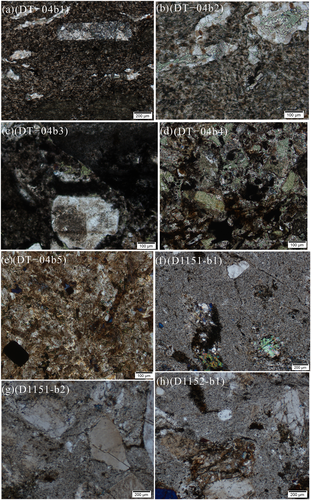
Five fresh volcanic rocks were sampled from the Dahongshan Formation (Datan area; Figure 2). The andesites (DT-04YQ1, DT-04YQ2, and DT-04YQ3) are dark grey in colour and commonly show a porphyritic texture with phenocrysts of plagioclase (15%±) and a small amount of potassium feldspar and dark mineral composition (1–5%) up to 0.3–2 mm in size. The plagioclase presents mostly a semi-self-shaped structure. The groundmass includes mainly plagioclase (60–65%), a small amount of potassium feldspar (10–15%), quartz (5%), and dark mineral composition (1–5%). The accessory minerals are apatite and opaque minerals. The andesitic tuffs (DT-04YQ4 and DT-04YQ5) are grey in colour and commonly show a sintered tuff texture. The rock consists of crystal fragments (35–40%), lithic fragment (35–40%), vitric fragment, and volcanic ash (25%±). The crystal fragments are composed of plagioclase (35%±), dark mineral fake (1–5%), and a small amount of quartz (less) up to 0.05–0.6 mm in diameter. The fragments are mainly composed of plagioclase, fake dark mineral, and quartz. The composition of lithic fragments are mainly tuff and andesite. The accessory minerals are apatite and opaque minerals (Figure 3).
3.2 Analytical methods
3.2.1 Mineral separation
Mineral separation was conducted at the Institute of the Hebei Regional Geology and Mineral Survey in Langfang, China. The mineral separation procedures are as follows. Samples were crushed to pass a 60-mesh sieve and then were manually cleansed by water and alcohol. We used an electromagnetometer to remove magnetic minerals and a heavy liquid to concentrate heavy minerals. Zircon grains were then handpicked under a binocular microscope. Zircon grains from individual samples were randomly mounted in epoxy resin and polished close to one third of individual grain diameters. Cathodoluminescence imaging was employed to investigate the internal texture of zircon, which in turn was used for selecting appropriate spots for U–Pb dating.
3.2.2 Zircon U–Pb isotopic dating
U–Pb dating of zircon was conducted using a laser ablation inductively coupled plasma mass spectrometry (LA-ICP-MS) in the Tianjin Institute of Geology and Mineral Resources, China. Zircon analyses of these samples were performed on the Neptune multiple-collector ICP-MS (Thermo FisherLtd.) with a 193-nm-FX ArF excimer laser-ablation system (ESILtd.) at the Isotopic Laboratory, Tianjin Institute of Geology and Mineral Resources. NIST610 glass was used as an external standard to calculate U, Th, and Pb concentrations of zircons, and the Pb concentration was corrected with the 208Pb method (Stacey & Kramers, 1975). In addition, TEMORA zircon was used as an external standard to normalize isotopic fractionation during the analysis. Uncertainties of individual analyses are reported with 1σ errors; weighted-mean ages are reported at the 2σ confidence level. Both the age calculations and concordia diagrams were made using Isoplot (Ludwig, 2003). The detailed analytical technique is given by Li, Geng, Hao, Zhang, and Li (2009).
3.2.3 Whole-rock geochemistry
Major oxides were analysed by the Phillips PW 1480 X-ray fluorescence spectrometer using fused glass disks at National Research Center of Geoanalysis, Chinese Academy of Geological Sciences in Beijing, China. Trace element abundances were obtained by ICP-MS hosted in the National Research Center for Geoanalysis, Chinese Academy of Geological Sciences in Beijing, China. After complete dissolution, powders (40 mg) were dissolved in distilled HF + HClO4 in 15-ml Savillex Teflon screw-cap breakers. The precision for most elements was typically better than 5% relative standard deviation, and the measured values for Zr, Hf, Nb, and Ta were within 10% of the certified values. The detailed sample preparations, instrument operating conditions, and calibration procedures follow those established by Liang and Grégoire (2000). Two standards (granite GSR-1 and basalt GSR-3) were utilized to monitor the analytical quality. The analytical margin of errors vary from 3% to 7% depending on any given elements concentration. An internal standard was used to monitor drift during analysis. The further details have been described by Gao et al. (2008).
4 RESULTS
4.1 LA-ICP-MS U–Pb dating of zircon
Sample DT1152-TW1 is collected from rhyolitic tuff. Zircons are generally euhedral to subhedral and predominantly exhibit concentric oscillatory zoning (Figure 5a). The particle size is between 80 and 120 μm and are mostly subeuhedral columnar crystals with length-to-width ratios approximately between 1:1 and 2:1. The zircons are mainly colourless, with a few that are yellowish-brown. Laser ablation sites show a range of Th/U ratios from 0.23 to 0.78, with an average value of 0.415 (Table 1). Analysed zircons are, therefore, of magmatic origin. In the 206Pb/238U–207Pb/235U concordia diagram (Figure 4), 24 analysis points for the 21 zircons are located on and near the concordia, and the weighted average age of the 206Pb/238U data is 280 ± 1 Ma (MSWD = 0.13), representing the crystallization age (Figure 4).
| Spots | Pb (ppm) | U (ppm) | Th/U | Isotopic ratios | Apparent ages(Ma) | ||||||||||
|---|---|---|---|---|---|---|---|---|---|---|---|---|---|---|---|
| 206Pb/238U | 1σ | 207Pb/235U | 1σ | 207Pb/206Pb | 1σ | 206Pb/238U | 1σ | 207Pb/235U | 1σ | 207Pb/206Pb | 1σ | ||||
| Sample DT-04TW3 | |||||||||||||||
| 1 | 5 | 130 | 0.93 | 0.0351 | 0.0004 | 0.3367 | 0.013 | 0.0696 | 0.003 | 222 | 2 | 295 | 12 | 915 | 79 |
| 2 | 19 | 392 | 0.82 | 0.0427 | 0.0004 | 0.3116 | 0.006 | 0.0529 | 0.001 | 270 | 3 | 275 | 5 | 324 | 37 |
| 3 | 17 | 300 | 1.34 | 0.0475 | 0.0005 | 0.3544 | 0.007 | 0.0541 | 0.001 | 299 | 3 | 308 | 6 | 376 | 41 |
| 4 | 144 | 366 | 0.99 | 0.3464 | 0.0048 | 7.7243 | 0.136 | 0.1617 | 0.002 | 1917 | 27 | 2199 | 39 | 2474 | 21 |
| 5 | 51 | 150 | 1.33 | 0.2750 | 0.0027 | 4.4331 | 0.068 | 0.1169 | 0.001 | 1566 | 16 | 1719 | 26 | 1909 | 23 |
| 6 | 260 | 538 | 0.65 | 0.4177 | 0.0042 | 9.3964 | 0.144 | 0.1631 | 0.002 | 2250 | 23 | 2377 | 37 | 2488 | 21 |
| 7 | 87 | 243 | 0.21 | 0.3488 | 0.0034 | 5.7962 | 0.088 | 0.1205 | 0.002 | 1929 | 19 | 1946 | 30 | 1964 | 23 |
| 8 | 13 | 292 | 0.37 | 0.0434 | 0.0004 | 0.3195 | 0.007 | 0.0535 | 0.001 | 274 | 3 | 282 | 6 | 348 | 41 |
| 9 | 231 | 711 | 0.23 | 0.3179 | 0.0032 | 5.3203 | 0.082 | 0.1214 | 0.002 | 1780 | 18 | 1872 | 29 | 1977 | 23 |
| 10 | 50 | 139 | 0.54 | 0.3281 | 0.0032 | 4.9829 | 0.077 | 0.1101 | 0.001 | 1829 | 18 | 1816 | 28 | 1802 | 24 |
| 11 | 42 | 328 | 0.63 | 0.1091 | 0.0012 | 2.0345 | 0.041 | 0.1352 | 0.002 | 668 | 7 | 1127 | 23 | 2167 | 27 |
| 12 | 12 | 178 | 0.95 | 0.0567 | 0.0006 | 0.4475 | 0.009 | 0.0572 | 0.001 | 356 | 3 | 376 | 7 | 501 | 38 |
| 13 | 16 | 207 | 2.43 | 0.0566 | 0.0006 | 0.4224 | 0.008 | 0.0542 | 0.001 | 355 | 3 | 358 | 7 | 378 | 40 |
| 14 | 106 | 379 | 0.51 | 0.2433 | 0.0024 | 5.0142 | 0.077 | 0.1495 | 0.002 | 1404 | 14 | 1822 | 28 | 2340 | 22 |
| 15 | 16 | 145 | 1.39 | 0.1020 | 0.0010 | 0.8655 | 0.021 | 0.0615 | 0.001 | 626 | 6 | 633 | 16 | 658 | 49 |
| 16 | 33 | 508 | 0.98 | 0.0557 | 0.0005 | 0.4153 | 0.007 | 0.0541 | 0.001 | 349 | 3 | 353 | 6 | 376 | 32 |
| 17 | 33 | 478 | 0.53 | 0.0664 | 0.0007 | 0.5254 | 0.009 | 0.0574 | 0.001 | 414 | 4 | 429 | 7 | 507 | 31 |
| 18 | 10 | 178 | 1.78 | 0.0436 | 0.0004 | 0.3191 | 0.009 | 0.0530 | 0.001 | 275 | 3 | 281 | 8 | 331 | 57 |
| 19 | 17 | 261 | 1.01 | 0.0551 | 0.0006 | 0.4392 | 0.009 | 0.0578 | 0.001 | 346 | 3 | 370 | 8 | 524 | 40 |
| 20 | 16 | 291 | 0.99 | 0.0461 | 0.0005 | 0.3528 | 0.008 | 0.0555 | 0.001 | 291 | 3 | 307 | 7 | 432 | 46 |
| 21 | 40 | 102 | 0.43 | 0.3643 | 0.0040 | 10.2684 | 0.177 | 0.2044 | 0.003 | 2002 | 22 | 2459 | 42 | 2862 | 21 |
| 22 | 42 | 331 | 0.09 | 0.1281 | 0.0014 | 1.8062 | 0.029 | 0.1023 | 0.001 | 777 | 9 | 1048 | 17 | 1666 | 25 |
| 23 | 7 | 88 | 0.79 | 0.0641 | 0.0006 | 0.8096 | 0.025 | 0.0916 | 0.003 | 401 | 4 | 602 | 19 | 1458 | 57 |
| 24 | 76 | 206 | 0.72 | 0.3373 | 0.0034 | 5.5257 | 0.087 | 0.1188 | 0.002 | 1874 | 19 | 1905 | 30 | 1938 | 23 |
| 25 | 7 | 123 | 0.75 | 0.0481 | 0.0005 | 0.3869 | 0.014 | 0.0583 | 0.002 | 303 | 3 | 332 | 12 | 542 | 76 |
| 26 | 61 | 1418 | 0.57 | 0.0402 | 0.0004 | 0.2935 | 0.005 | 0.0530 | 0.001 | 254 | 3 | 261 | 4 | 329 | 30 |
| 27 | 161 | 991 | 0.61 | 0.1473 | 0.0015 | 3.0653 | 0.048 | 0.1510 | 0.002 | 886 | 9 | 1424 | 22 | 2357 | 22 |
| 28 | 135 | 317 | 0.42 | 0.3771 | 0.0038 | 8.3828 | 0.129 | 0.1612 | 0.002 | 2063 | 21 | 2273 | 35 | 2468 | 21 |
| 29 | 20 | 80 | 0.93 | 0.1955 | 0.0022 | 3.2540 | 0.065 | 0.1207 | 0.002 | 1151 | 13 | 1470 | 30 | 1967 | 31 |
| 30 | 5 | 75 | 1.45 | 0.0546 | 0.0006 | 0.4118 | 0.019 | 0.0547 | 0.003 | 343 | 4 | 350 | 17 | 400 | 104 |
| 32 | 621 | 2128 | 0.09 | 0.2846 | 0.0032 | 6.2873 | 0.102 | 0.1602 | 0.002 | 1614 | 18 | 2017 | 33 | 2458 | 21 |
| 34 | 163 | 339 | 0.83 | 0.3991 | 0.0040 | 8.7944 | 0.134 | 0.1598 | 0.002 | 2165 | 22 | 2317 | 35 | 2454 | 21 |
| 35 | 30 | 94 | 0.48 | 0.2998 | 0.0030 | 4.5187 | 0.071 | 0.1093 | 0.001 | 1690 | 17 | 1734 | 27 | 1788 | 24 |
| 36 | 95 | 293 | 0.24 | 0.3116 | 0.0030 | 5.1910 | 0.079 | 0.1208 | 0.002 | 1749 | 17 | 1851 | 28 | 1968 | 23 |
| Sample D1152 | |||||||||||||||
| 1 | 11 | 284 | 0.50 | 0.0444 | 0.0001 | 0.3194 | 0.000 | 0.0522 | 0.001 | 280 | 2 | 281 | 4 | 293 | 36 |
| 2 | 15 | 379 | 0.34 | 0.0444 | 0.0001 | 0.3180 | 0.000 | 0.0519 | 0.001 | 280 | 2 | 280 | 3 | 282 | 26 |
| 3 | 34 | 890 | 0.78 | 0.0444 | 0.0001 | 0.3192 | 0.000 | 0.0521 | 0.000 | 280 | 2 | 281 | 2 | 291 | 15 |
| 4 | 24 | 614 | 0.29 | 0.0445 | 0.0001 | 0.3192 | 0.000 | 0.0520 | 0.000 | 281 | 2 | 281 | 2 | 285 | 20 |
| 5 | 70 | 1820 | 0.28 | 0.0444 | 0.0002 | 0.4293 | 0.000 | 0.0701 | 0.001 | 280 | 2 | 363 | 6 | 931 | 22 |
| 6 | 21 | 547 | 0.32 | 0.0444 | 0.0003 | 0.6403 | 0.001 | 0.1047 | 0.002 | 280 | 2 | 503 | 13 | 1709 | 42 |
| 7 | 21 | 549 | 0.55 | 0.0445 | 0.0001 | 0.3180 | 0.000 | 0.0519 | 0.000 | 280 | 2 | 280 | 2 | 280 | 17 |
| 8 | 16 | 418 | 0.40 | 0.0444 | 0.0001 | 0.3189 | 0.000 | 0.0521 | 0.000 | 280 | 2 | 281 | 3 | 288 | 21 |
| 9 | 13 | 326 | 0.39 | 0.0444 | 0.0001 | 0.3175 | 0.000 | 0.0519 | 0.001 | 280 | 2 | 280 | 4 | 280 | 28 |
| 10 | 65 | 1683 | 0.52 | 0.0447 | 0.0001 | 0.3165 | 0.000 | 0.0514 | 0.000 | 282 | 1 | 279 | 2 | 259 | 15 |
| 11 | 38 | 986 | 0.26 | 0.0444 | 0.0001 | 0.3192 | 0.000 | 0.0521 | 0.000 | 280 | 1 | 281 | 2 | 290 | 16 |
| 12 | 25 | 646 | 0.28 | 0.0445 | 0.0001 | 0.3175 | 0.000 | 0.0518 | 0.000 | 281 | 2 | 280 | 2 | 275 | 16 |
| 13 | 34 | 897 | 0.57 | 0.0444 | 0.0001 | 0.3176 | 0.000 | 0.0519 | 0.000 | 280 | 2 | 280 | 2 | 280 | 15 |
| 14 | 27 | 711 | 0.24 | 0.0443 | 0.0001 | 0.3189 | 0.000 | 0.0522 | 0.000 | 280 | 2 | 281 | 2 | 292 | 16 |
| 15 | 29 | 755 | 0.45 | 0.0446 | 0.0001 | 0.3181 | 0.000 | 0.0517 | 0.000 | 281 | 2 | 280 | 4 | 273 | 20 |
| 16 | 4 | 99 | 0.60 | 0.0444 | 0.0002 | 0.5356 | 0.000 | 0.0874 | 0.003 | 280 | 2 | 436 | 16 | 1370 | 64 |
| 17 | 14 | 375 | 0.36 | 0.0445 | 0.0001 | 0.3191 | 0.000 | 0.0520 | 0.001 | 281 | 2 | 281 | 3 | 285 | 27 |
| 18 | 24 | 624 | 0.23 | 0.0444 | 0.0001 | 0.3184 | 0.000 | 0.0520 | 0.000 | 280 | 2 | 281 | 3 | 286 | 18 |
| 19 | 21 | 556 | 0.32 | 0.0445 | 0.0001 | 0.3195 | 0.000 | 0.0521 | 0.000 | 281 | 2 | 282 | 3 | 289 | 18 |
| 20 | 93 | 2421 | 0.42 | 0.0446 | 0.0001 | 0.3175 | 0.000 | 0.0517 | 0.000 | 281 | 2 | 280 | 2 | 270 | 14 |
| 21 | 20 | 516 | 0.49 | 0.0444 | 0.0001 | 0.3173 | 0.000 | 0.0518 | 0.000 | 280 | 2 | 280 | 3 | 278 | 21 |
| 22 | 33 | 855 | 0.46 | 0.0447 | 0.0001 | 0.3195 | 0.000 | 0.0519 | 0.000 | 282 | 2 | 281 | 2 | 279 | 15 |
| 23 | 22 | 581 | 0.35 | 0.0444 | 0.0001 | 0.3172 | 0.000 | 0.0518 | 0.000 | 280 | 2 | 280 | 3 | 277 | 21 |
| 24 | 22 | 564 | 0.57 | 0.0443 | 0.0001 | 0.3180 | 0.000 | 0.0520 | 0.000 | 280 | 1 | 280 | 3 | 287 | 19 |
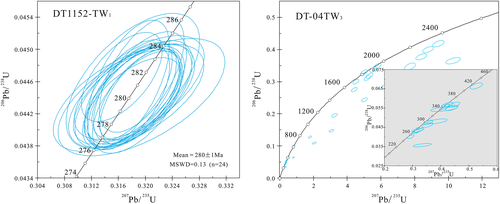
Sample DT-04TW3 is collected from andesitic volcanic breccia. Zircons are generally euhedral to subhedral and predominantly exhibit concentric oscillatory zoning (Figure 5b). The particle size is 50–120 μm in length and with aspect ratios approximately between 1:1 and 2:1. The zircons are mainly colourless, with a few that are yellowish-brown. Laser ablation sites show a range of Th/U ratios from 0.1 to 2.4, with an average value of 0.850 (Table 1), indicating a magmatic origin. Thirty-six analyses produced a 206Pb/238U age range of 2,488 to 254 Ma (Table 1), which yielded two concordant groups of ages at 1,911 ± 63 Ma (n = 5) and 267 ± 6 Ma (n = 7; Figure 4). These data indicate that the andesitic volcanic breccia formed at 267 ± 6 Ma, with the older age representing inherited or captured zircons entrained by the andesitic volcanic breccia (Figure 4).
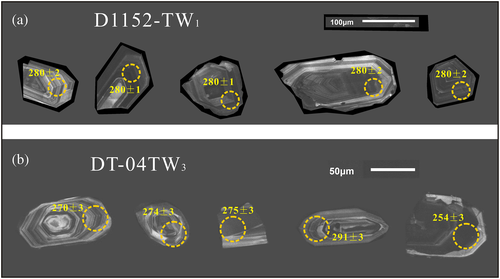
4.2 Major and trace elements
A total of 10 Early Permian volcanic samples were analysed for major and trace element compositions. The loss on ignition for most samples is approximately 1 wt.%. The result is presented in Table 2.
| Samples | DT-04QY1 | DT-04QY2 | DT-04QY3 | DT-04QY4 | DT-04QY5 | D1151-YQ1 | D1151-YQ2 | D1152-YQ1 | D3030-YQ1 | D3030-YQ2 |
|---|---|---|---|---|---|---|---|---|---|---|
| SiO2 | 62.77 | 65.78 | 59.27 | 54.91 | 72.83 | 75.48 | 72.29 | 71.52 | 49.01 | 49.53 |
| TiO2 | 0.92 | 1.06 | 1.09 | 0.81 | 0.16 | 0.16 | 0.27 | 0.29 | 0.15 | 0.16 |
| Al2O3 | 13.79 | 15.49 | 16.05 | 16.06 | 14.37 | 12.78 | 14.2 | 14.36 | 2.88 | 2.88 |
| Fe2O3 | 1.36 | 1.08 | 4.16 | 3.34 | 1.1 | 0.45 | 0.74 | 0.72 | 6.65 | 4.36 |
| FeO | 3.93 | 2.82 | 2.25 | 3.5 | 0.56 | 1.44 | 1.77 | 2.02 | 1.84 | 4.08 |
| MnO | 0.17 | 0.1 | 0.12 | 0.11 | 0.04 | 0.044 | 0.045 | 0.055 | 0.072 | 0.079 |
| MgO | 2.08 | 1.48 | 1.84 | 3.84 | 0.17 | 0.34 | 0.57 | 0.62 | 45.38 | 47.51 |
| CaO | 3.7 | 2.2 | 3.86 | 5.48 | 0.23 | 0.94 | 1.44 | 2.12 | 7.62 | 6.19 |
| Na2O | 3.17 | 3.92 | 3.85 | 2.71 | 4.46 | 2.77 | 2.74 | 2.91 | 0.29 | 0.77 |
| K2O | 1.51 | 1.87 | 2.29 | 1.65 | 3.94 | 4.55 | 4.72 | 4.16 | 0.21 | 0.42 |
| P2O5 | 0.28 | 0.32 | 0.43 | 0.22 | 0.03 | 0.04 | 0.08 | 0.083 | 0.03 | 0.033 |
| LOI | 4.74 | 3.32 | 3.88 | 6.18 | 1.14 | 0.94 | 0.96 | 0.98 | 0 | 0 |
| La | 45.2 | 48 | 44.2 | 23.5 | 49.1 | 54.36 | 31.83 | 42.32 | 4.97 | 3.02 |
| Ce | 94.8 | 101 | 90.9 | 47.8 | 97 | 99.76 | 76.77 | 84.72 | 10.49 | 7.22 |
| Pr | 10.8 | 11.8 | 10.8 | 6.05 | 10.7 | 11.74 | 7.56 | 9.48 | 1.27 | 0.9 |
| Nd | 43.5 | 47.2 | 43.1 | 26.2 | 38.7 | 42.42 | 27.33 | 33.96 | 5.09 | 3.61 |
| Sm | 7.35 | 8 | 7.49 | 4.4 | 6.25 | 7.24 | 4.8 | 5.99 | 0.98 | 0.73 |
| Eu | 2.01 | 2.18 | 2.02 | 1.43 | 0.68 | 0.53 | 0.94 | 1.09 | 0.27 | 0.18 |
| Gd | 6.27 | 6.69 | 6.41 | 3.86 | 5.01 | 6.35 | 4.51 | 5.41 | 0.94 | 0.69 |
| Tb | 0.85 | 0.94 | 0.87 | 0.54 | 0.74 | 0.92 | 0.66 | 0.77 | 0.14 | 0.11 |
| Dy | 4.63 | 5.16 | 4.63 | 2.92 | 4.1 | 4.79 | 3.76 | 4.19 | 0.84 | 0.63 |
| Ho | 0.93 | 1.04 | 0.92 | 0.58 | 0.82 | 0.94 | 0.77 | 0.81 | 0.15 | 0.12 |
| Er | 2.77 | 3.02 | 2.7 | 1.65 | 2.55 | 2.86 | 2.36 | 2.48 | 0.45 | 0.37 |
| Tm | 0.37 | 0.41 | 0.36 | 0.21 | 0.35 | 0.46 | 0.38 | 0.4 | 0.08 | 0.07 |
| Yb | 2.52 | 2.8 | 2.39 | 1.42 | 2.4 | 3.05 | 2.58 | 2.78 | 0.55 | 0.43 |
| Lu | 0.38 | 0.41 | 0.36 | 0.21 | 0.37 | 0.55 | 0.46 | 0.49 | 0.1 | 0.08 |
| Y | 24.2 | 26.9 | 24.8 | 15 | 22.4 | 26.78 | 21.46 | 24.22 | 4.436 | 3.201 |
| Th | 6.04 | 6.83 | 5.17 | 2.1 | 10.3 | 17.52 | 16.23 | 14.96 | 1.61 | 1.56 |
| U | 1.99 | 2.07 | 1.19 | 0.57 | 2.69 | 3.04 | 2.22 | 2.27 | 0.42 | 0.49 |
| Cs | 4.67 | 4.43 | 3.38 | 4.37 | 2.33 | 9.88 | 9.07 | 8.63 | 9.41 | 9.59 |
| Sc | 13.3 | 14.6 | 17.1 | 18.9 | 5.17 | 8.07 | 6.57 | 6.63 | 5.61 | 5.89 |
| Rb | 40.3 | 51.2 | 60.7 | 41.3 | 77.2 | 203.3 | 183.7 | 167.9 | 6.9 | 11 |
| Sr | 553 | 557 | 736 | 636 | 275 | 58.4 | 186.5 | 203.2 | 171.9 | 115.9 |
| Ba | 1,025 | 1,234 | 987 | 927 | 2,486 | 349.8 | 988.3 | 952.1 | 468.4 | 762.1 |
| Zr | 241 | 282 | 219 | 121 | 260 | 105.9 | 172.1 | 182.8 | 40.3 | 39 |
| Nb | 9.05 | 10.4 | 8.19 | 4.59 | 11.9 | 15.07 | 14.81 | 14.5 | 2.69 | 2.64 |
| Ta | 0.51 | 0.57 | 0.46 | 0.26 | 0.72 | 1.26 | 1.22 | 1.11 | 0.22 | 0.16 |
| Hf | 6.74 | 7.56 | 5.87 | 3.39 | 7.97 | 3.78 | 6.11 | 6.35 | 1.39 | 1.19 |
| Pb | 22.8 | 18 | 15.9 | 10.5 | 29.6 | ---- | ---- | ---- | ---- | ---- |
| V | 44.4 | 54 | 112 | 186 | 8.29 | 24.4 | 26.8 | 24 | 31.7 | 30.2 |
| Co | 5.43 | 3.08 | 9.61 | 19.7 | 1.19 | 2.6 | 3.9 | 3.8 | 77.2 | 67.1 |
| Ni | 0.62 | 0.35 | 6.2 | 8.07 | 2.06 | 6.2 | 4.3 | 3 | 1,287 | 1,083 |
| Cu | 7.41 | 10.7 | 14.7 | 11.1 | 8.75 | 4.3 | 6 | 5.6 | 12.2 | 10.7 |
| Zn | 93.2 | 84.4 | 91.7 | 87.3 | 41.4 | 60.7 | 55 | 55.6 | 31.7 | 32.8 |
| Ga | 18.5 | 20.8 | 21.7 | 19.1 | 16.2 | 18.39 | 19.02 | 18.73 | 2.56 | 2.46 |
| Cr | 0.62 | 0.92 | 13.2 | 21.1 | 2.69 | 13.3 | 7.7 | 6.1 | 1,128 | 1,158 |
4.2.1 Early Permian Dahongshan Formation volcanic rocks
The Dahongshan Formation volcanic rocks are characterized by SiO2 (54.91–72.83 wt.%), Al2O3 (13.79–16.06 wt.%), MgO (0.17–3.84 wt.%), CaO (0.23–5.48 wt.%), Na2O (2.71–4.46 wt.%), K2O (1.51–3.94 wt.%), (Na2O + K2O) = (4.36–8.40 wt.%), with quite high K2O/Na2O ratios of 0.476–0.883 and TiO2 (0.16–1.09 wt.%; Table 2). In SiO2–K2O diagram (Figure 7; Peccerillo & Taylor, 1976), these andesitic rocks plot in the mid- to high-K calc-alkaline series. In the TAS diagram (Figure 6; LeMaitre, 2002), these andesites fall into the fields of basaltic andesite, andesite, rhyolite, belonging to alkaline. In the chondrite-normalized rare earth element (REE) diagram (Figure 8; Boynton, 1984), these andesitic rocks show strongly right-inclined chondrite-normalized REE patterns, with enrichments in light rare earth elements (LREEs; LaN/YbN = 6.48–14.67) and well-defined negative Eu anomalies (Eu/Eu* = 0.36–1.037). In the primitive mantle-normalized trace element diagram (Figure 9; Sun & McDonough, 1989), they exhibit a depletion in high-field strength elements (HFSEs; e.g., Th, Nb, Ta, P, and Ti) and an enrichment in large-ion lithophile elements (LILEs; e.g., Ba, K, and Sr).
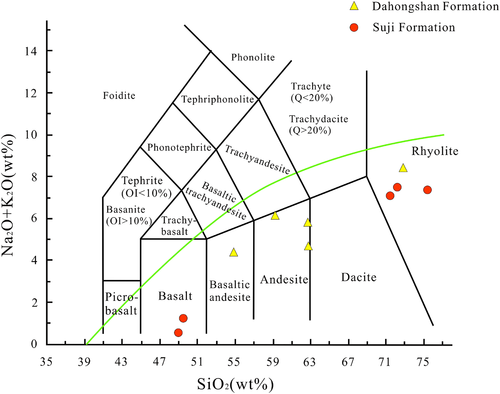
4.2.2 Early Permian Suji Formation volcanic rocks
The mafic rocks from Suji Formation are characterized by SiO2 (49.01–49.53 wt.%), Al2O3 (2.88 wt.%), MgO (45.38–47.51 wt.%), CaO (6.19–7.62 wt.%), Na2O (0.29–0.77 wt.%), K2O (0.21–0.42 wt.%), (Na2O + K2O) = (6.61–7.83 wt.%), with quite high K2O/Na2O ratios of 0.545–0.724 and TiO2 (0.15–0.16 wt.%; Table 2). In SiO2–K2O diagram, these andesitic tuffs plot in the low-K tholeiitic series (Figure 7; Peccerillo & Taylor, 1976). In the TAS diagram (Figure 6; LeMaitre, 2002), these andesitic tuffs plot in the basalt zone, belonging to calc-alkaline, which may be due to the altered effect. In the chondrite-normalized REE diagram (Figure 8; Boynton, 1984), these andesitic tuffs show highly right-inclined chondrite-normalized REE patterns, with enrichments in LREEs (LaN/YbN = 5.04–6.48) and weekly negative Eu anomalies (Eu/Eu* = 0.764–0.848). In the primitive mantle-normalized trace element diagram (Figure 9; Sun & McDonough, 1989), they show a depletion in HFSEs (e.g., Th, Nb, Ta, P, and Ti) and an enrichment in LILEs (e.g., Ba, K, and Sr).
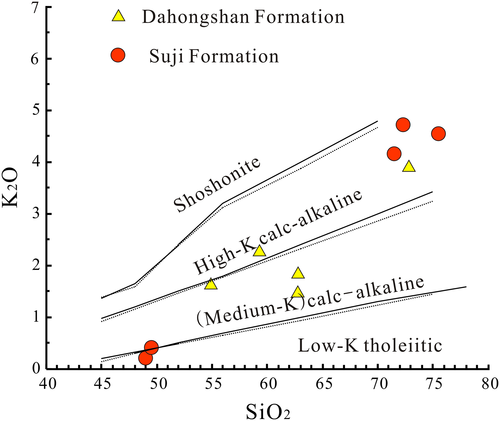
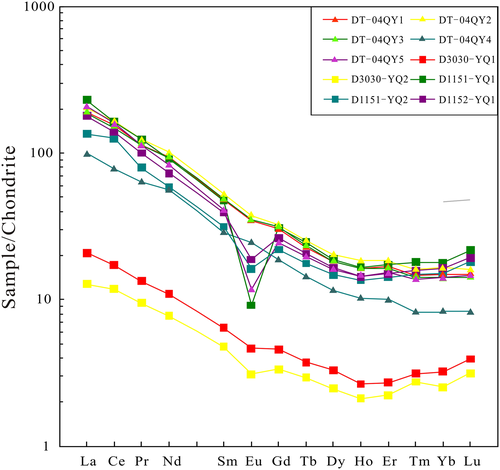

The felsic rocks from Suji Formation are characterized by SiO2 (71.52–75.48 wt.%), Al2O3 (12.78–14.36 wt.%), MgO (0.34–0.62 wt.%), CaO (0.94–2.12 wt.%), Na2O (2.74–2.91 wt.%), K2O (4.16–4.72 wt.%), (Na2O + K2O) = (7.07–7.46 wt.%), with quite high K2O/Na2O ratios of 1.430–1.72 and TiO2 (0.16–0.29 wt.%; Table 2). In the TAS diagram (Figure 6; LeMaitre, 2002), these rhyolite tuffs plot in the rhyolite zone, belonging to calc-alkaline. In SiO2–K2O diagram (Figure 7; Peccerillo & Taylor, 1976), these rhyolite tuffs plot in the high-K calc-alkaline series. In the chondrite-normalized REE diagram (Figure 8; Boynton, 1984), these rhyolite tuffs show right-inclined chondrite-normalized REE patterns, with week enrichments in LREEs (LaN/YbN = 8.85–12.78) and strongly negative Eu anomalies (Eu/Eu* = 0.233–0.608). In the primitive mantle-normalized trace element diagram (Figure 9; Sun & McDonough, 1989), they display depletion in Nb, Ta, Sr, P, and Ti and enrichment in Rb, Th, and K.
On the Harker diagram (Figure 10), Al2O3, CaO, Fe2O3, MgO, P2O5, and TiO2 show negative linear correlations with SiO2 (Figure 10a–c,f–h), whereas K2O shows a positive correlation (Figure 10d); Na2O shows large variations without a clear trend (Figure 10e). The strong correlations between SiO2 and the other major elements all of which suggested that fractional crystallization played an important role in the magmatic process.

5 DISCUSSION
5.1 Ages of the volcanic rocks from the Suji and Dahongshan formations
The Suji Formation volcanic rocks are exposed across the northern margin of the Plate Marginal Orogenic Belt (Figures 1 and 2). Field geological survey suggested that the Suji Formation volcanic rocks are intruded by the Middle Permian granite, and unconformably cover the Mesoproterozoic–Neoproterozoic strata (Figure 2). Zhang, Zhao, et al. (2016) reported the Suji Formation volcanic rocks formed at 278–261 Ma in the Bayan Obo-Damaoqi area according to LA-ICP-MS and SHRIMP zircon U–Pb dating. In this study, the sample (D1152-TW1) from the Suji Formation in the north-eastern Damaoqi area shows an overall age of 280 ± 1 Ma. Therefore, these dating results for the Suji Formation volcanic rocks lead us to conclude that a continuous magmatic event occurred in the northern margin of the Plate Marginal Orogenic Belt from 280 to 261 Ma (Early Permian).
The Dahongshan Formation volcanic rocks are exposed across the southern margin of the Plate Marginal Orogenic Belt (Figures 1 and 2). The previous field geological survey suggested that the age of the Dahongshan Formation formed from the Carboniferous to Permian (IGSCUGB, 2008). However, Li et al. (2017) reported that andesite from the Dahongshan Formation formed at 277 ± 1.4 Ma in the Datan area according to LA-ICP-MS zircon U–Pb dating. In this study, the sample (DT-04TW3) from the Dahongshan Formation in Datan area shows an age of 267 ± 6 Ma. Consequently, these dating results for volcanic rocks from the Dahonshan Formation lead us to conclude that a continuous magmatic event occurred in the southern margin of the Plate Marginal Orogenic Belt from 277 to 267 Ma (Early Permian).
Based on the above, the ages of the volcanic rocks from the Suji and Dahongshan formations formed at 280–261 Ma and 277–267 Ma, respectively. Spatially, the Late Palaeozoic volcanic rocks displayed a wide area across central Inner Mongolia and crosscut several major tectonic units that are rarely associated with clear tectonic structures (Figures 1 and 2).
5.2 Petrogenesis of volcanic rocks from the Suji and Dahongshan formations
The mafic-intermediate rocks from the Suji Formation are low in SiO2 (49.01–49.53 wt.%) high in MgO (45.38–47.52 wt.%) and Fe2O3 (4.36–6.65 wt.%) than those of any crustal materials (Rudnick & Gao, 2003) or crust-derived melts (Patiño Douce, 1997), relative to primitive-mantle-derived magmas, suggesting they were derived from relatively evolved melts (Frey & Prinz, 1978). These andesitic rocks from the Dahongshan Formation are characterized by high SiO2 contents (54.91–72.83 wt.%), low content of MgO (0.17–3.84 wt.%) and low Mg# values, indicating they were mainly crust-derived, probably related to underplating of the mafic magma derived from partial melting of the mantle wedge and subducted oceanic crust (Zhang, Liu, et al., 2016). The Harker diagrams (Figure 10) also suggested that these intermediate volcanics possess a fractional crystallization trend, indicating varying degrees of fractional crystallization.
The andesitic tuffs belong to the subalkaline series (Figure 6) and mainly plot into the low-K tholeiitic to calc-alkaline fields on the K2O–SiO2 diagram (Figure 7). Furthermore, they are characterized by high enrichment in LREEs and LILEs and depletion in HFSEs and high REE, with relatively high La/Nb (1.14–14.67) and low La/Ba (0.003–0.15) values. These features are similar to those of magmatism result from an active continental margin arc (Eiler et al., 2000; Gill, 1981; Grove et al., 2003; Grove & Kinzler, 1986), suggesting that their mantle source could be a depleted mantle wedge that had been metasomatized before partial melting. Formation of the Early Permian volcanic rocks in an active continental margin arc tectonic setting is further confirmed by negative Nb and Ta anomalies of mafic rocks (Figure 9), which is typically characterized by many subduction-related magmatic rocks (Briqueu, Bougault, & Joron, 1984; Murphy, 2007; Rogers & Hawkesworth, 1989). The andesitic tuffs have enrichment in K suggested that the rock forming process is influenced by the continental crust. In the Y–Cr and Y–La–Nb diagrams (Figures 11 and 12; Cabanis & Lecolle, 1989; Pearce, 1982), the andesitic rocks respectively plotted into the “VAB” and “calc-alkaline basalts” zone, with two samples plotted outside of the region owing to the late alteration (influence), all of which indicated that the material source is mainly from the continental arc zone.
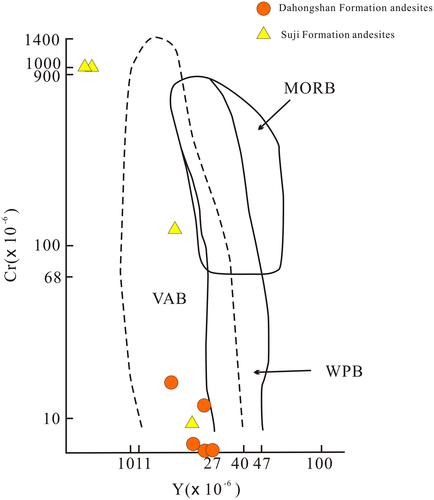
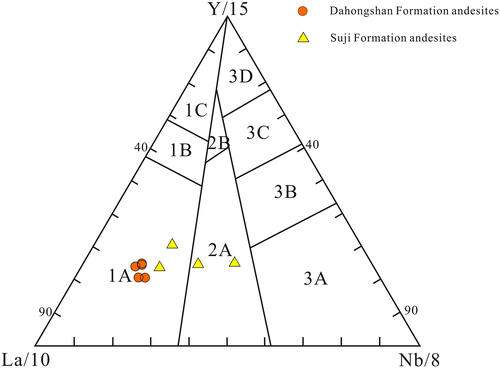
The felsic rocks from the Suji Formation mainly include dacite, rhyolite, and rhyolitic porphyry (IMIGS, 2003; Zhang, Liu, et al., 2016). Based on the spatiotemporal distribution of the volcanic rocks from Suji Formation in study area, such a large-scale felsic magma could not have been produced by the fractional crystallization of mantle-derived magma (Xu & Qiu, 2010). Considering characteristics of the felsic rocks from the Suji Formation, marked by high SiO2 (71.52–75.48 wt%); low MgO (0.34–0.62 wt%); Cr and Ni contents; significant negative Nb, Ta, P, and Ti anomalies; positive Th, Zr, and Hf anomalies, pronounced highly negative Eu anomalies, and the nature of calc-alkaline shown in the K2O–SiO2 diagram (Figure 7), all of which suggested that they were mainly crust-derived, with the enrichment of plagioclase but absence of garnet in the residual phase (Rapp & Watson, 1995), probably related to underplating of the mafic magma derived from partial melting of the mantle wedge and subducted oceanic crust. In the 10,000 Ga versus Zr and Zr + Nb + Ce + Y versus (Na2O + K2O)/CaO diagrams, the felsic rocks plotted into the “I + S type granites” zone (Whalen, Currie, & Chappell, 1987; Figure 13). In the Y–Nb diagram, the felsic rocks plotted into the “volcanic arc granites” zone (Pearce, Harris, & Tindle, 1984; Figure 14). As shown in a previous study (Zhang, Zhao, et al., 2016), these trace element characteristics indicated that the study area may located in a subduction-related active continental margin arc setting the Early Permian. Therefore, the primary magma of the felsic rocks probably originated from the partial melting of dominantly juvenile crustal components with a possible addition of “old” materials, induced by the heat provided by the passage of contemporaneous basaltic magma derived from the underlying mantle wedge.
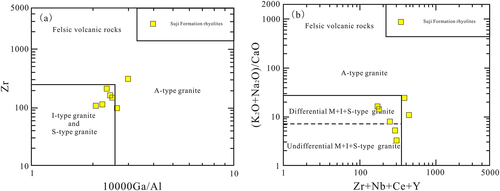
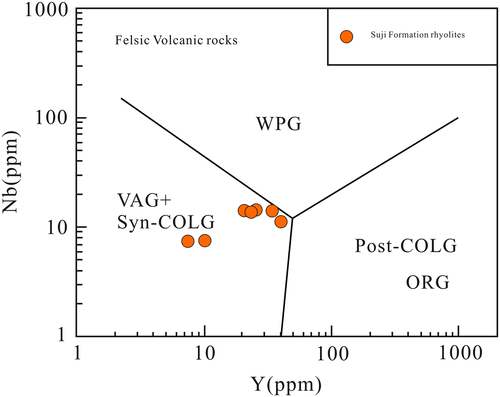
5.3 Tectonic implications
Tectonic implications of the different types of Late Palaeozoic volcanic rocks in central Inner Mongolia have been investigated in recent decades (Tang, 1990; Nie et al., 1994; Zhu et al., 2001; Zhang, 2008; Chen et al., 2014; Chen et al., 2015; Li et al., 2014, 2015; Li et al., 2016; Zhang et al., 2017; Yu et al., 2017). Several tectonic models have been proposed to explain the tectonic setting of the Late Palaeozoic volcanic rocks in central Inner Mongolia and adjacent regions. These models are as follows: (a) postorogenic lithospheric extension related to postcollisional delamination (Chen et al., 2014; Li et al., 2014; Li et al., 2016; Zhang, 2008; Zhang et al., 2017); (b) partial melting of a mantle wedge by the northward or southward subduction of the PAO (Gao & Jiang, 1998; Xiao et al., 2003; Yu et al., 2017; Zhang, Zhao, et al., 2016), and (c) continental rifting that developed in response to broadly distributed regional tension (Tang, 1990).
Now, an obvious question is whether all these Late Palaeozoic volcanic rocks formed in a common tectonic setting.
The new geochemical data indicate that the Early Permian volcanic rocks from the Dahongshan and Suji formations belong to the mid-K or high-K calc-alkaline series. All of the samples are characterized by enrichment in LREEs and LILEs, and depletion in HREEs and HFSEs (e.g., Nb, Ta, and Ti). Such geochemical features indicate that the Early Permian volcanic rocks in the northern margin of the NCC formed in an active continental margin setting (Gill, 1981; Grove et al., 2003; Grove & Kinzler, 1986; Pearce, 1982; Zhang, Liu, et al., 2016). This conclusion is also supported by the following evidences: (a) The felsic volcanic rocks, widely distributed throughout the Suji and Dahongshan formations, exhibit enrichment in LILEs and depletion in HFSEs, with prominent Nb, Ta, P, and Ti troughs (Figure 9). These features indicate that the magma source had been modified by the subducted slab-derived fluids (Turner, Sandiford, & Foden, 1992; Zhang, 2008); (b) all of the andesitic rock samples from the Dahongshan and Suji formations plot within the “VAB” and “calc-alkaline basalts” in the tectonic setting discrimination diagrams of Y–Cr (Figure 11; Pearce, 1982) and La–Y–Nb (Figure 12; Cabanis & Lecolle, 1989), suggesting that the Early Permian Dahongshan and Suji formations andesitic rocks may have been generated by the subduction of the PAO crust beneath the northern margin of the NCC; (c) the Suji Formation felsic volcanic rocks have the features of “I + S type granites” in the tectonic setting discrimination diagrams of 10,000 Ga/Al versus Zr diagram and Zr + Nb + Ce + Y versus (Na2O + K2O)/CaO diagram (Figure 13; Whalen et al., 1987), implying that the Early Permian Suji Formation felsic volcanic rocks may also have been generated by the southward subduction of the PAO crust beneath the northern margin of the NCC; (d) finally, the Late Palaeozoic volcanic rocks in the Plate Marginal Orogenic Belt along the northern margin of the NCC also have geochemical affinities to active continental margin volcanics. Zhang, 2008 proposed that volcanic rocks from the Suji Formation in the same district formed along an active continental margin.
The polarity of subduction of the PAO crust may be southern in the Early Permian; the recognition can be supported by the following evidences: (a) The Rb–SiO2 diagram (Ninkovich & Donn, 1976; Figure 15) indicated that the distance between the Suji Formation volcanic rocks in the northern margin of the Plate Marginal Orogenic Belt and subduction zone is about 120–150 km, similar with the distance between the Dahongshan Formation volcanic rocks in the southern margin of the Plate Marginal Orogenic Belt and subduction zone, together with the long distance of the Suji and Dahongshan formations volcanic rocks in the northern-southern margin of the Plate Marginal Orogenic Belt (70–90 km, Li et al., 2017; Figures 1 and 2), suggesting that the subduction of the PAO crust may be a flat subduction beneath the Plate Marginal Orogenic Belt along the northern margin of the NCC. (b) Crustal thickness is a direct reflection of the growth of the Earth's crust, related to the arc maturity, which can be estimated by the different geochemistry parameters (Condie, 1973; Windley, 1977). The Rb–Sr diagram (Condie, 1973; Mazumder, Bose, & Sarkar, 2000; Figure 15) suggested that the Suji Formation volcanic rocks in the northern margin of the Plate Marginal Orogenic Belt suggested crustal thickness is about 15–30 km, least more than 30 km. However, the Dahongshan Formation volcanic rocks in the southern margin of the Plate Marginal Orogenic Belt suggested that crustal thickness is about 30 km, most more than 30 km (the mature continental crust >30 km). Changing from the transitional continental crust in the north to the mature continental crust in the south suggested that the subduction director of the PAO crust is southern. (c) The Early Permian continental arc volcanism are widely exposed across the northern margin of the Plate Marginal Orogenic Belt from west to east, but this type volcanic rocks grow less and less to the south (Zhang, Liu, et al., 2016). Similarly, the Early Permian intrusive rocks developed in the northern margin of the NCC were caused by the continued southward subduction of the PAO crust (Liu, Li, et al., 2016; Zhang et al., 2009; Zhang & Zhao, 2013; Zhang, Zhao, Song, et al., 2009).

Combined with the above, we propose that the Early Permian Dahongshan and Suji formations volcanic rocks formed along an Andean-type active continental margin arc, closely related to the southward flat subduction of the PAO crust beneath the northern margin of the NCC. This conclusion also implies that the final collision between the NCC and the SC did not occur before the Early Permian.
Based on the Late Palaeozoic magmatic time and tectonic setting reported in this study, we thus reconstruct the following evolution model:
Stage I (280 to 261 Ma, the subduction phase of the PAO): The single seafloor subduction of the PAO crust beneath the northern margin of the NCC occurred at ~280 Ma. Intensive related-subduction Early Permian continental arc volcanic rocks (Suji and Dahongshan formations volcanic rocks) widely spread in the northern margin of the NCC (Li et al., 2017; Zhang, Liu, et al., 2016). In comparison, a large scale of 311–276 Ma bimodal volcanic rocks (e.g., Dashizhai Formation), but lack of 280–261 Ma (Figures 1 and 2), was widely developed in the Airgin Sum-Xilinhot blocks (Chen et al., 2014; Li et al., 2016; Zhang, 2008; Zhang et al., 2017), in which the thick Middle Permian Zhesi Formation limestone deposited (Wang et al., 2008), all of which suggest that a stable passive continental margin setting formed in the southern margin of the Airgin Sum-Xilinhot blocks during the Early Permian to Middle Permian (Liu, Li, et al., 2016). Based on geochemical data of granitoids, Liu, Wu, et al. (2016) and Zhang, Zhao, Song, et al. (2009) also suggested that the PAO was still being subducted beneath the northern margin of the NCC during this period. Li et al. (2017) proposed that the Plate Marginal Orogenic Belt along the northern margin of the NCC was beginning to uplift in the end of the Early Permian, related to the southward subduction of the PAO crust beneath the northern margin of the NCC (Figure 16a).
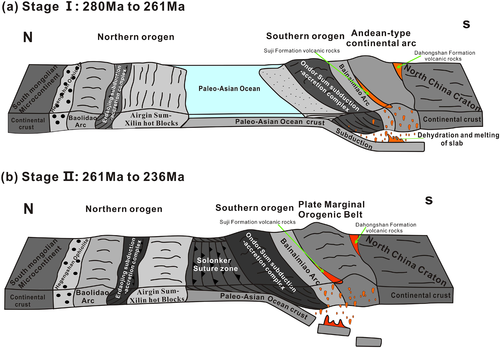
Stage II (261 to 236 Ma, the closure phase of the PAO): The widespread high Sr and syncollisional/VAG granitoids revealing the collisional orogenic setting developed in the northern margin of the NCC indicated that the continent–continent collision between the NCC and the SC in the Middle Permian to Middle Triassic (Liu et al., 2014; Liu, Yang, Wu, & Zhang, 2010; Wu et al., 2011; Zhang, Zhang, Liu, & Zhou, 2009). Li et al. (2017) reported that the Plate Marginal Orogenic Belt formed along the northern margin of the NCC in this period, related to the southward subduction and final closure of the PAO crust (Figure 16b).
6 CONCLUSIONS
- New LA-ICP-MS zircon U–Pb dating suggests that the Suji and Dahongshan formations volcanic rocks in the study area occurred in 280 ± 1 Ma and 267 ± 6 Ma, respectively. Together with the previous studies, the Suji and Dahongshan formations volcanic rocks formed in 280–261 Ma and 277–267 Ma, respectively.
- Suji and Dahongshan formations volcanic rocks in the Plate Marginal Orogenic Belt exhibit subduction-related geochemical features and form in an Andean-type continental arc tectonic setting, and its development is related to the southward flat subduction of the PAO crust beneath the northern margin of the NCC, indicating that the final collision between the NCC and the SC did not occur before the Early Permian.
- We provide an updated view of the late stage tectonic evolution of the PAO during the Late Palaeozoic. Our model has the following key features: (a) Southward flat subduction of the PAO crust beneath the northern margin of the NCC in the Early Permian to Middle Permian led to the development of the active continental margin arc volcanic rocks; (b) with the final closure of the PAO, the Plate Marginal Orogenic Belt formed along the northern margin of the NCC in the Middle Permian to Middle Triassic.
ACKNOWLEDGEMENTS
We sincerely thank Ms Lizhen Chen for her help in testing samples from this study. This work was financially supported by the National Natural Science Foundation of China (Grants 41772227 and 41702054), the Fundamental Research Funds for the Central Universities (Grant 2652017222) and the China Geological Survey (Grants 1212010811001, 1212011220465, 1212011085490, 12120114093901, and DD20160045-2).



